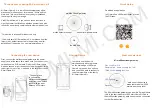
Section 8 DETAILED MENU REFERENCE
123
Utility Menu Item Details
Xmt
Transmit (encoding) mode
This menu item selects the method used to encode local audio for transmission to the
remote site.
The remote unit must be set to a compatible receive mode
.
Zephyr offers the choice of IS0/MPEG Layers III and II, as well as G.722. Selection
of transmit mode is accomplished by choosing the item in the UTILITY menu and using
the <NO (- )> button to change the mode displayed. The <YES (+)> button must be
pressed to accept and store your selection.
Xmt modes may be changed while a call is in progress.
Available modes are:
•
L3 DUAL
Layer III Single or Dual Channel Monaural
This selection is used for independent monaural audio channels using Layer III.
This mode permits the transmission of one mono signal over a single 56/64kbps
channel. In addition, two signals can be sent to a single site or to two different
locations over two 56/64kbps transmission channels.
15kHz audio bandwidth per channel is achieved with the recommended 32kHz
sample rate. 20kHz audio bandwidth is achieved per channel with a 48kHz sample
rate.
The two audio channels are “tagged,” so that encode channel A appears on the
decoder’s channel A, and encode channel B appears on the decoder’s channel B,
regardless of a swap of the transmission paths.
Dual Site Operation
It is possible to use the dual mono transmit mode to send to two receivers at different
sites. Set the transmit mode to
L3 DUAL
and dial each site.
IMPORTANT!
The following Xmt modes require a 5 DSP (Stereo) Zephyr: L3
STEREO, L3 JSTEREO, L2 MONO-128, L2 DUAL, L2
JSTEREO. A 3 DSP (Mono) Zephyr will display “Hardware Not
Available” if these modes are selected. For information on
Zephyr configurations see manual section 2 (Introduction). A 3
DSP (Mono) Zephyr can be upgraded to 5 DSP (Stereo);
Contact Telos customer support for additional information.
IMPORTANT!
Changing the Xmt, Rcv, or Rate options while connected will
cause the Zephyr to cease transmitting and receiving audio as
the new code is loaded.
HOT TIP!
A typical application which works perfectly within the
constraints given above is the one used for dual-language
sports broadcasts, with separate studio sites. LIII DUAL mode
is used from the stadium to the two separate studio sites, while
G.722 is used for the cueing channel from the studios back to
the stadiums.
Summary of Contents for Zephyr
Page 13: ...Table of Contents 13 SECTION 1 QUICK RESULTS ...
Page 26: ...Section 2 INTRODUCTION 26 This page intentially left blank ...
Page 27: ...Section 2 INTRODUCTION 27 SECTION 2 INTRODUCTION ...
Page 38: ...Section 2 INTRODUCTION 38 This page intentionally left blank ...
Page 39: ...39 SECTION 3 ZEPHYR AT A GLANCE ...
Page 52: ...Section 4 INSTALLATION BASIC OPERATION 52 This page intentionally left blank ...
Page 53: ...Section 4 INSTALLATION BASIC OP 53 SECTION 4 INSTALLATION BASIC OPERATION ...
Page 84: ...Section 4 INSTALLATION BASIC OPERATION 84 ...
Page 85: ...Section 5 ISDN 85 SECTION 5 ISDN ...
Page 105: ...Section 6 NON ISDN NETWORKS 105 SECTION 7 AUDIO CODING ...
Page 118: ...Section 7 AUDIO CODING PRINCIPLES 118 This page intentionally left blank ...
Page 119: ...Section 8 DETAILED MENU REFERENCE 119 SECTION 8 DETAILED MENU REFERENCE ...
Page 157: ...Section 9 REMOTE CONTROL 157 SECTION 9 REMOTE CONTROL ...
Page 176: ...Section 9 REMOTE CONTROL 176 This page intentionally left blank ...
Page 177: ...Section 10 ADVANCED PROBLEM SOLVING 177 SECTION 10 ADVANCED PROBLEM SOLVING ...
Page 196: ...Section 10 ADVANCED PROBLEM SOLVING 196 This page intentionally left blank ...
Page 197: ...Section 11 TECHNICAL INFORMATION 197 SECTION 11 DETAILED TECHNICAL INFORMATION ...
Page 219: ...Section 12 SCHEMATICS 219 SECTION 12 SCHEMATICS ...
Page 221: ...Section 13 MANUFACTURER S DATA SHEETS 221 SECTION 13 MANUFACTURER S DATA SHEETS ...
Page 223: ...Section 14 SPECIFICATIONS WARRANTY 223 SECTION 14 SPECIFICATIONS AND WARRANTY ...
Page 228: ...228 This page intentionally left blank ...
Page 229: ...Section 15 APPENDICES 229 SECTION 15 APPENDICES ...
















































